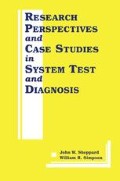Abstract
The implementation of test improvements can have a significant impact on product lifecycle costs. However, the time lag in accruing potential benefits can be problematic when attempting to justify the required investment. This can be overcome if a phased implementation is adopted where each interim level of investment delivers less substantial but more immediate gains. This chapter demonstrates that techniques previously used to investigate cost-saving opportunities at strategic and lifecycle level can be used within a system manufacturing process to achieve tangible short-term benefits. The failure profile of a system level test process is characterized and used to drive defect elimination and optimum test times. Various “stopping criteria”, product-process comparisons and improvements are discussed.
Access this chapter
Tax calculation will be finalised at checkout
Purchases are for personal use only
Preview
Unable to display preview. Download preview PDF.
References
Chillarege, R. and N. S. Bowen. 1989. “Understanding Large System Failures — A Fault Injection Experiment”. IEEE, 19th International Symposium on Fault Tolerant Computing, pp 356–363.
Chillarege, R. and R. K. Iyer. May 1987. “Measurement-Based Analysis of Error Latency”. IEEE Transactions on Computers. Vol. C-36, No. 5.
Czeck, E. W. and D. P. Siewiorek. May 1992. “Observations on the Effects of Fault Manifestation as a Function of Workload”. IEEE, Transactions on Computers. Vol. 41, No 5. pp559–566.
Dear, I. D., A. P. Ambler and C. Maunder. 1992. “M. Abadir and S. Sastry, Ellis Horwood, ISBN 0-13-22476
Dislis, C., I.D. Dear, J. R. Miles, S.C. Lau and A.P. Ambler. 1989. “Cost Analysis of Test Method Environments”. IEEE, Proceedings of the International Test Conference. pp875–883.
Dislis, D., March 1992. “A Financially Based Automated Advisor for Design for Test Strategy Generation”. PhD Thesis, Brunei University.
Fairen, D. and A. Ambler. 1995. “Cost Effective System-Level Test Strategies”. IEEE, Proceedings of the International Test Conference. pp 807–813.
Fairen, D. and A. P. Ambler. 1994. “System Test Cost Modeling based on Event Rate Analysis”. IEEE, Proceedings of the International Test Conference. pp 84–92.
Goel, A. L. and K. Okumoto. August 1979. “Time-Dependent Error-Detection Rate Model for Software Reliability and other Performance Measures”. IEEE, Transactions on Reliability. Vol. R-28, No. 3.
Gray, J. January 1986. “Why Do Computers Stop And What Can Be Done About It ?”. IEEE, Proceedings of the 5th Symposium on Reliability in Distributed Software and Database Systems. pp 3–12.
Krten, O. J. and D. A. Levy. 1980. “Software Modeling for Optimal Field Entry”. Proceedings of the Annual Reliability and Maintainability Symposium. pp 410–414.
Maxwell, P. C. and R. C. Aitken. March 1993. “Test Sets and Reject Rates: All Fault Coverage’s Are Not Created Equal”. IEEE, Design and Test of Computers.
McGough, J. G., F. L. Swern and S. Bavuso. 1983. “New Results in Fault Latency Modeling”. IEEE, EASCON Conference. pp 299–306.
Moore, T. J., 1994. “A Test Process Optimization and Cost Modeling Tool”, Proceedings of the International Test Conference. pp 103–110.
Ohtera, H., S. Yamada, and H. Narihisa. August 1990. “Software Availability based on Reliability Growth Models”. Transactions of the IEICE. Vol. E 73, No. 8.
Shin, K. G. and Y. H. Lee. April 1986. “Measurement and Application of Fault Latency”. IEEE, Transactions on Computers. Vol. C-35, No. 4.
Tegethoff, M. M. V. and T.W Chen, 1994 “Manufacturing Test Simulator: A Concurrent Engineering Tool for Boards and MCMs”. Proceedings of the International Test Conference. pp 903–910.
Turino, J. October 1994. “Lifetime Cost Implications of Chip-Level DFT”, Test Synthesis Seminar, IEEE International Test Conference, TS Paper 2.2.
Wohl, J. G. May/June 1982. “Maintainability Prediction Revisited: Diagnostic Behavior, System Complexity, and Repair Time”. IEEE, Transactions on Systems, Man, and Cybernetics. Vol. SMC-12, No 3. pp 241–250.
Author information
Authors and Affiliations
Rights and permissions
Copyright information
© 1998 Springer Science+Business Media New York
About this chapter
Cite this chapter
Farren, D., Chan, W., Ambler, A.P. (1998). System Level Test Process Characterization and Improvement. In: Research Perspectives and Case Studies in System Test and Diagnosis. Frontiers in Electronic Testing, vol 13. Springer, Boston, MA. https://doi.org/10.1007/978-1-4615-5545-2_7
Download citation
DOI: https://doi.org/10.1007/978-1-4615-5545-2_7
Publisher Name: Springer, Boston, MA
Print ISBN: 978-1-4613-7535-7
Online ISBN: 978-1-4615-5545-2
eBook Packages: Springer Book Archive

